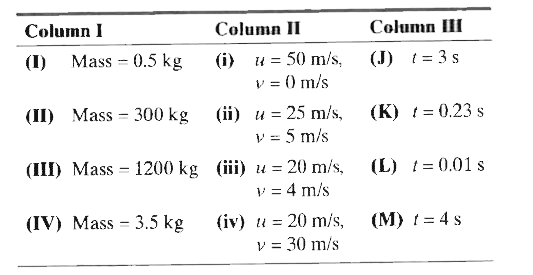The force applied on an object will not lead to a change in
the shape of the object
the mass of the object
its direction of motion
its position
To solve the question "The force applied on an object will not lead to a change in," we need to analyze the options provided: shape of the object, mass of the object, direction of motion, or position.
1. Understanding the Effects of Force:
- When a force is applied to an object, it can cause various changes in the object's properties or state of motion. We need to identify which of the given options does not change when force is applied.
2. Option A: Shape of the Object:
- Applying force can change the shape of an object. For example, if you crumple a cardboard box or squeeze a sponge, the shape changes. Therefore, this option is incorrect.
3. Option B: Mass of the Object:
- The mass of an object is a measure of the amount of matter it contains. When a force is applied, it does not change the mass of the object. For example, if you push a box, its mass remains the same regardless of the force applied. Thus, this option is correct.
4. Option C: Direction of Motion:
- Force can change the direction of motion of an object. For instance, if you kick a rolling football, the direction in which it moves changes. Therefore, this option is incorrect.
5. Option D: Position:
- Applying a force can also change the position of an object. For example, pushing a box from one location to another will change its position. Hence, this option is also incorrect.
6. Conclusion:
- After analyzing all the options, we conclude that the force applied on an object will not lead to a change in the mass of the object. Therefore, the correct answer is Option B: mass of the object.
- When a force is applied to an object, it can cause various changes in the object's properties or state of motion. We need to identify which of the given options does not change when force is applied.
- Applying force can change the shape of an object. For example, if you crumple a cardboard box or squeeze a sponge, the shape changes. Therefore, this option is incorrect.
- The mass of an object is a measure of the amount of matter it contains. When a force is applied, it does not change the mass of the object. For example, if you push a box, its mass remains the same regardless of the force applied. Thus, this option is correct.
- Force can change the direction of motion of an object. For instance, if you kick a rolling football, the direction in which it moves changes. Therefore, this option is incorrect.
- Applying a force can also change the position of an object. For example, pushing a box from one location to another will change its position. Hence, this option is also incorrect.
- After analyzing all the options, we conclude that the force applied on an object will not lead to a change in the mass of the object. Therefore, the correct answer is Option B: mass of the object.
Similar Questions
An impulse is supplied to a moving object with the force at an angle 120∘with the velocity vector. The angle between the impulse vector and the change in momentum vector is
View SolutionAn object of mass 16kg is moving with an acceleration of 3m/s^(2). Calculate the applied force.If the same force is applied on an object of mass 24kg ,how much will be the acceleration?
View Solution
Knowledge Check
- Question 1 - Select One
If the force applied on the object is in the direction of motion, the speed of the object .........
AincreasesBstopsCdecreasesDno effect - Question 2 - Select One
Force acts on an object may change
AdirectionBshapeCspeedDall of above - Question 3 - Select One
As long as an unbalanced force is applied to a body, there is a continuos change in its.
AweightBmassCspeedDshape
Pseudo force is applied in
View SolutionFill in the following blanks with suitable words:
b) If the two force applied to an object are equal and act in opposite directions, the net force acting on the object will be ……….View SolutionForce acts on an object may change
View SolutionIn the given table, Column I shows masses of the objects, Column II shows the initial and final velocity of the object after force is applied on it and Column III shows the time span for which force is applied on the object.

Conditions for a hammer with the force of 2500 N applied in opposite direction of motion are:View SolutionA force is applied to an object that is free to move. Which of the following statements is correct?
View Solution

